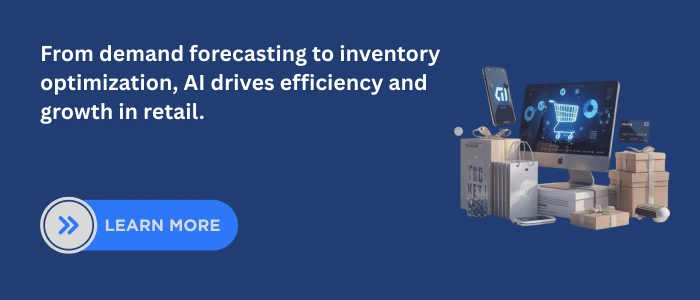Introduction
Artificial Intelligence (AI) is transforming retail by enabling smarter decisions, streamlining operations, and enhancing customer experiences. Using machine learning, predictive analytics, and computer vision, AI helps retailers improve engagement, optimize supply chains, and reduce costs. AI personalizes shopping by segmenting customers, predicting preferences, and tailoring offers. It boosts efficiency by automating inventory and logistics while reducing waste. It fuels innovation through product recommendations, AR fitting tools, and fraud detection.
Retail executives must adopt AI today as markets demand agility, competitors use smart technologies, and consumers expect personalized experiences. Partnering with experts in enterprise AI development services ensures scalable, secure, and future-ready adoption.
1. AI Use Cases in Retail
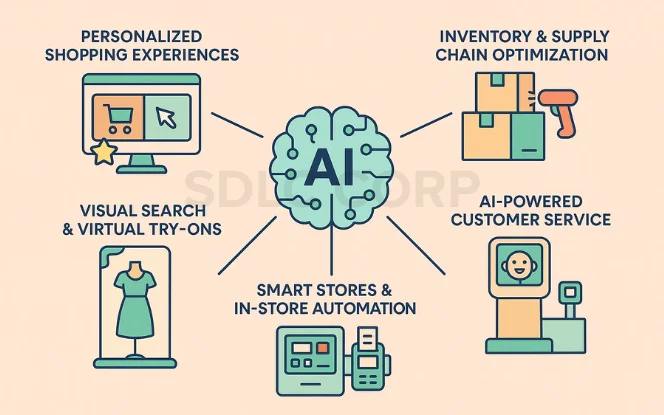
Artificial Intelligence reshapes retail by driving efficiency, enabling hyper-personalization, and delivering smarter operations. Retailers adopt AI across multiple domains to enhance customer experience, reduce costs, and unlock sustainable growth.
Personalized Shopping Experiences
AI analyzes customer behavior, purchase history, and browsing patterns to deliver tailored recommendations.
- Recommendation engines personalize product suggestions in real time.
- Chatbots and voice assistants ensure 24/7 engagement with consistent responses.
- Predictive models anticipate shopper needs before purchase intent surfaces.
Example: Amazon’s recommendation engine drives 35% of total purchases, proving the impact of personalization at scale.
Inventory and Supply Chain Optimization
AI predicts demand through advanced machine learning forecasting models.
- Retailers use predictive analytics to balance demand and supply.
- Automated restocking reduces delays and stock-outs.
- Real-time dashboards improve visibility across distribution networks.
Example: Walmart applies AI forecasting and achieves 16% fewer shelf stock-outs, ensuring products remain available.Retail supply chain AI solutions also reduce excess inventory, improve logistics, and lower carbon footprint — supporting sustainability while maintaining profitability
AI-Powered Customer Service
AI assistants manage customer inquiries in real time with natural language understanding.
- Virtual agents resolve issues without human escalation.
- Machine learning enables these systems to continuously improve accuracy.
- Automation reduces operational costs while improving customer satisfaction.
Example: Starbucks’ Deep Brew platform increases ROI by 30% by optimizing customer engagement.
Visual Search and Virtual Try-Ons
Computer vision enables customers to discover products by uploading images.
- AI algorithms identify similar products instantly.
- Augmented Reality (AR) try-ons allow customers to visualize purchases.
- Reduced return rates improve profitability and customer trust.
Example: IKEA’s AR app drives a 35% increase in sales and reduces return rates significantly.
Smart Stores and In-Store Automation
AI transforms physical stores into smart ecosystems.
- Computer vision enables cashierless checkout experiences.
- Robotics perform repetitive tasks like shelf scanning and cleaning.
- Data-driven automation ensures operational efficiency at scale.
Example: Amazon Go’s “just walk out” model delivers frictionless shopping while reducing fraud.
Table: AI Use Cases in Retail
| AI Application | Example | Business Impact |
|---|---|---|
| Personalized Marketing | Amazon | 35% of sales from recommendations |
| Demand Forecasting | Walmart | 16% fewer stock-outs |
| AI Customer Service | Starbucks | 30% ROI increase |
| AR Try-On | IKEA | 20–30% fewer returns |
| Smart Checkout | Amazon Go | Higher satisfaction, less fraud |
2. Future Trends in Retail AI
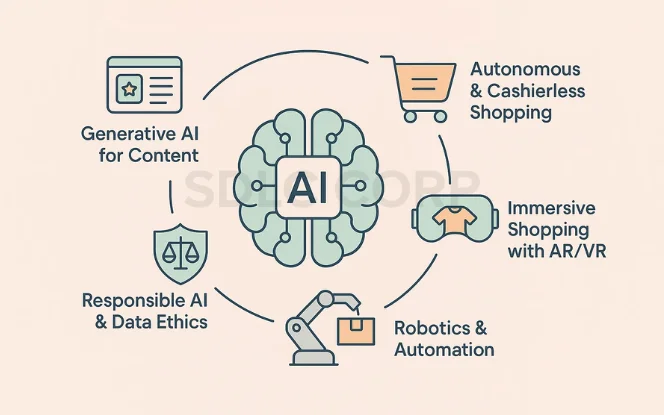
AI in retail evolves rapidly and introduces transformative trends that redefine how businesses operate. These innovations drive competitive advantage, improve customer trust, and prepare enterprises for the digital-first economy
Generative AI for Content
Generative AI creates product descriptions, marketing copy, and visuals automatically. Beyond retail, Generative AI for Fintech shows how industries like banking and financial services apply AI to automate compliance and scale personalization.
- Retailers use AI to generate personalized product pages at scale.
- AI systems produce multilingual content instantly to support global expansion.
- Visual generation tools craft dynamic ads that increase customer engagement.
Retailers gain agility when they deploy content faster, reduce costs, and maintain brand consistency..
Autonomous and Cashierless Shopping
AI enables autonomous checkout systems with computer vision and smart carts. These systems evolve into Autonomous AI Workflows that manage retail operations end-to-end without human intervention.
- Customers place items in carts while AI tracks selections in real time.
- Mobile payments integrate seamlessly to deliver frictionless exits.
- Retailers cut labor costs while maintaining operational accuracy.
Consumers increasingly prefer frictionless shopping experiences because they save time and reduce queue frustration.
Immersive Shopping with AR/VR
Augmented Reality (AR) and Virtual Reality (VR) transform how consumers interact with products.
- AR-powered fitting rooms allow shoppers to try before they buy digitally.
- VR showrooms showcase full product ranges in engaging virtual spaces.
- Retailers reduce product returns while increasing conversion rates.
Immersive shopping creates trust because customers visualize purchases more accurately.
Robotics and Automation
AI-powered robotics enhance both warehouses and in-store operations. Emerging innovations like Digital Twins in AI simulate entire supply chains, allowing retailers to predict disruptions and optimize workflows.
- Robots manage warehouse picking, packaging, and last-mile delivery.
- Autonomous machines handle shelf scanning and store cleaning.
- AI-driven robotics augment staff efficiency instead of replacing human roles.
Retailers improve productivity, cut costs, and deliver consistent service quality.
Responsible AI and Data Ethics
Responsible AI adoption becomes essential for long-term sustainability.
- Transparent systems ensure fairness in personalization and pricing.
- Compliance with regulations builds consumer trust.
- Ethical frameworks prevent bias in decision-making algorithms.
Retailers integrate data ethics into their AI strategy because trust defines brand loyalty in the digital age.
3. Implementation Roadmap for AI in Retail
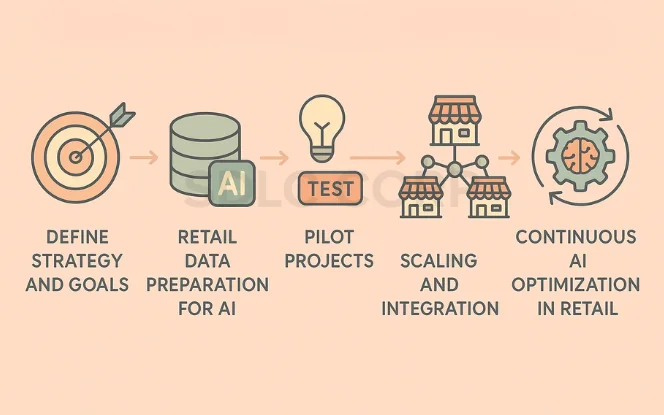
A structured roadmap ensures that AI adoption in retail delivers measurable impact. Retailers must approach implementation methodically to reduce risks, align investments, and maximize returns.
Step 1: Define Strategy and Goals
Retailers begin by aligning AI initiatives with clear and measurable KPIs.
- AI projects must link to outcomes such as higher sales, reduced costs, or improved customer experience.
- Leadership teams must provide sponsorship and allocate resources for long-term adoption.
When strategy aligns with business goals, AI programs deliver sustainable value.
Step 2: Retail Data Preparation for AI
AI requires accurate and comprehensive datasets to perform effectively.
- Customer and supply chain data must integrate across platforms.
- Data cleaning ensures accuracy, consistency, and usability.
- Retailers enforce privacy compliance and invest in secure data infrastructure.
A strong data foundation allows AI systems to generate reliable insights.
Step 3: Pilot Projects
Retailers validate AI through pilot initiatives before scaling.
- Controlled experiments test use cases such as dynamic pricing, chatbots, or demand forecasting.
- Success metrics, ROI targets, and customer feedback guide evaluation.
- Pilot outcomes determine which AI solutions are ready for broader deployment.
Pilots minimize risks while demonstrating AI’s tangible business value.
For example, small retailers can start with AI-powered chatbots or predictive inventory tools, before expanding into advanced AI systems like cashierless checkout or AR try-ons.
Step 4: Scaling and Integration
Retailers expand AI adoption by rolling out proven solutions at scale.
- Deployments extend across stores, e-commerce platforms, and supply chains.
- Employee training ensures staff collaborate effectively with AI systems.
- Seamless integration connects AI platforms with existing business processes.
Scalable deployment transforms isolated projects into enterprise-wide advantages.
Step 5: Continuous AI Optimization in Retail
AI solutions must evolve to stay effective in dynamic retail markets. Advances such as Tool-Using AI Agents make this possible by autonomously connecting with retail tools, APIs, and workflows for faster optimization.
- Models retrain with new data to maintain accuracy.
- Teams track KPIs continuously to refine strategies.
- Retailers nurture a culture of innovation that embraces AI experimentation.
Ongoing optimization ensures AI initiatives remain competitive and future-ready.
4. Case Studies
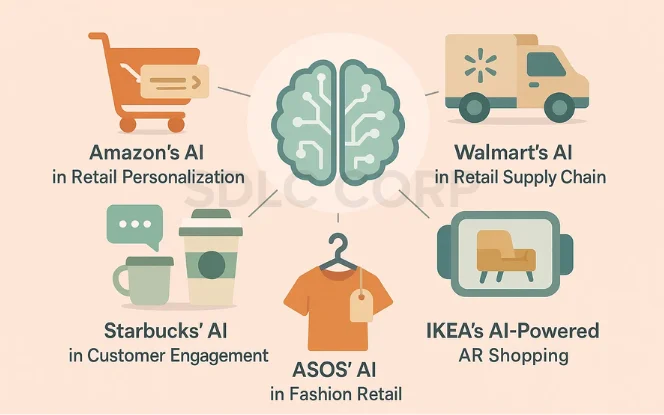
Case studies illustrate how global retailers successfully adopt AI. Each example demonstrates measurable business outcomes, improved efficiency, and enhanced customer experiences.
Case Study: Amazon’s AI in Retail Personalization
Amazon applies AI across personalization, logistics, and cashierless retail.
- AI recommendation engines analyze customer behavior and drive 35% of total sales.
- Machine learning models optimize logistics, warehouse automation, and delivery routes.
- Amazon Go stores apply computer vision to enable cashierless shopping.
AI empowers Amazon to boost personalization and improve sales efficiency at scale.
Case Study: Walmart’s AI in Retail Supply Chain
Walmart leverages AI to optimize operations and enhance sustainability.
- AI-driven demand forecasting reduces shelf stock-outs and improves stock management.
- Automated logistics systems streamline delivery networks and lower costs.
- Sustainability initiatives use AI to minimize waste and improve resource efficiency.
AI enables Walmart to reduce costs, improve sustainability, and enhance customer service consistently.
Case Study: Starbucks’ AI in Customer Engagement
Starbucks employs its AI platform, Deep Brew, to personalize the customer journey.
- Deep Brew delivers individualized offers through mobile apps and loyalty programs.
- Voice ordering systems enhance convenience and expand customer engagement.
- AI analytics track customer preferences and adjust recommendations in real time.
Starbucks gains higher ROI, stronger loyalty, and improved customer satisfaction.
Case Study: ASOS’ AI in Fashion Retail
ASOS integrates AI into its fashion retail operations.
- Styling assistants suggest clothing combinations tailored to user preferences.
- Size prediction algorithms minimize incorrect orders and reduce returns.
- Visual search tools allow customers to find products by uploading images.
AI adoption enables ASOS to achieve higher profits and lower return rates across markets.
Case Study: IKEA’s AI-Powered AR Shopping
IKEA uses AI-powered AR to transform the shopping journey.
- AR applications allow customers to visualize furniture inside their homes.
- AI enhances personalization in product suggestions and virtual showrooms.
- Reduced uncertainty in purchases results in fewer returns and greater confidence.
AI and AR integration helps IKEA to increase sales and lower return percentages effectively.
5. Challenges and Best Practices in AI Adoption for Retail
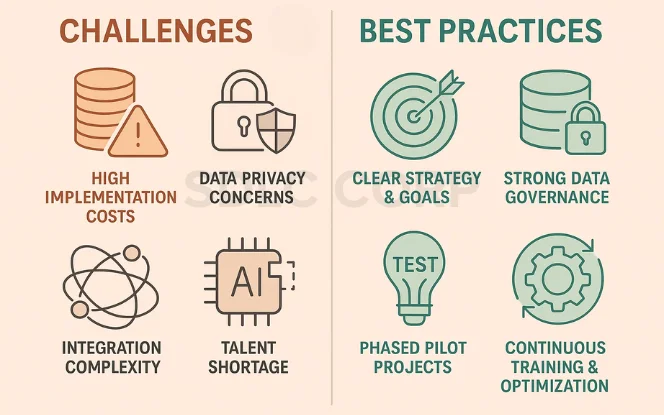
Retail executives recognize that AI adoption is not without obstacles. However, by applying proven best practices, they mitigate risks and accelerate value creation. AI becomes not just a technology upgrade but a long-term competitive differentiator.
Challenges of AI Adoption in Retail
- High Implementation Costs
AI requires significant investment in data infrastructure, cloud platforms, and skilled talent. Many retailers hesitate due to high upfront costs, despite long-term ROI potential.
- Data Quality & Governance Issues
AI systems depend on clean, consistent data. Poor governance and siloed datasets reduce accuracy, making predictive models unreliable.
- Change Management Resistance
Employees often fear job displacement when AI is introduced. Without proper training and communication, cultural resistance slows adoption.
- Integration with Legacy Systems
Most retailers operate on outdated ERP, CRM, or POS systems. Integrating modern AI platforms with these legacy systems is complex and creates inefficiencies.
Best Practices for Successful AI Adoption
- Start Small, Scale Fast
Launch pilot projects such as chatbots or demand forecasting. Once results are proven, expand AI adoption across supply chains, stores, and e-commerce platforms.
- Invest in High-Quality Data
Create a centralized, secure, and clean data pipeline. Strong governance ensures both compliance and reliable AI outcomes.
- Upskill and Empower Employees
Train staff to work alongside AI tools instead of fearing them. Reskilling builds confidence, reduces resistance, and fosters a culture of AI-driven innovation.
- Measure ROI Continuously
Track KPIs such as revenue uplift, reduced stock-outs, customer engagement, and cost savings. Clear ROI validation guides future AI investments.
- Ensure Responsible & Ethical AI
Adopt Bias Mitigation in AI to avoid unfair recommendations or pricing.
Example: In 2019, an AI system used by a retailer was criticized for offering higher credit limits to men than women, even when profiles were similar. Responsible AI frameworks prevent such bias, ensuring fairness and regulatory compliance.
Key Takeaway
AI adoption in retail is not just about technology it’s about people, processes, and trust. By starting small, prioritizing data quality, upskilling employees, and embracing ethical AI, retailers can unlock AI’s full potential and build sustainable competitive advantage.
6. ROI and Business Impact of AI in Retail
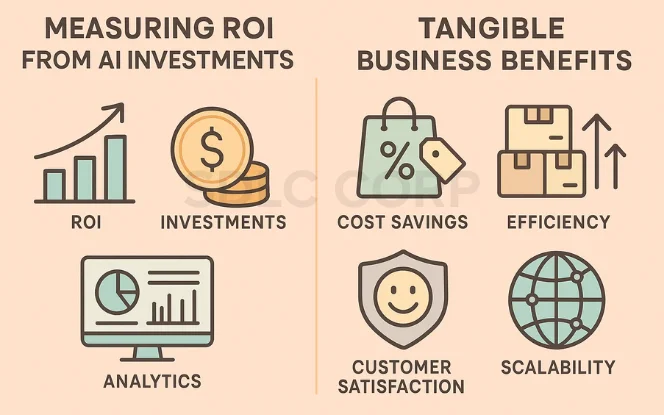
Retail executives increasingly focus on ROI to justify AI initiatives. When measured correctly, AI consistently delivers double-digit returns, making it one of the most impactful investments in the retail sector.
Measuring ROI from AI Investments
Retailers measure ROI using clear KPIs:
- Sales Uplift: AI-driven personalization increases average order value (AOV) and overall revenue.
- Cost Reduction: Predictive analytics improves demand forecasting and reduces waste.
- Customer Retention: Targeted offers and loyalty programs strengthen engagement.
- Operational Efficiency: Automated workflows minimize errors and reduce overhead.
Tangible Business Benefits
AI in retail delivers measurable outcomes across multiple areas:
- Revenue Growth: Personalized recommendations drive significant sales contributions.
- Operational Efficiency: Fewer stock-outs reduce carrying costs.
- Customer Loyalty: AI-powered personalization improves engagement scores by up to 30%.
- Fraud Reduction: AI monitoring systems detect anomalies and reduce financial losses.
According to McKinsey, AI in retail can deliver an ROI uplift of 10–20% annually when applied at scale.
Table: ROI Metrics in AI for Retail
| KPI/Metric | AI Impact Example | Business Outcome |
|---|---|---|
| Sales Uplift | Amazon recommendations = 35% of sales | Higher revenue per customer |
| Cost Reduction | Walmart AI inventory = 16% fewer stock-outs | Leaner operations, reduced losses |
| Customer Engagement | Starbucks personalization = +30% ROI | Stronger loyalty, repeat purchases |
| Return Reduction | IKEA AR try-on = 20–30% fewer returns | Higher profitability per order |
According to McKinsey, AI in retail can deliver an ROI uplift of 10–20% annually when applied at scale, making it one of the most lucrative technology investments.
Conclusion
FAQs
1. What is AI in retail?
AI in retail uses technologies like machine learning, natural language processing, and computer vision to personalize shopping, automate operations, and improve business decisions.
2. How does AI improve customer experience?
AI improves customer experience by delivering personalized product recommendations, enabling chatbots for 24/7 support, and offering AR/VR try-ons that reduce returns and boost satisfaction
3. What are the main use cases of AI in retail?
Key AI use cases include personalized marketing, demand forecasting, AI customer service, cashierless checkout, and visual search. Each application drives efficiency and increases revenue.
4. What challenges do retailers face in adopting AI?
Retailers face challenges such as high implementation costs, data quality issues, integration with legacy systems, and employee resistance. Strong governance and change management address these obstacles.
5. What are the future trends of AI in retail?
Future trends include generative AI for content, cashierless smart stores, immersive AR/VR shopping, robotics for automation, and responsible AI practices to ensure trust and compliance.
6. How can small retailers use AI affordably?
Small retailers can adopt AI through cloud-based tools such as AI chatbots, predictive demand software, or visual search features, which are cost-effective and scalable.
7. What is the cost of implementing AI in retail?
The cost depends on the scope. Small AI projects like chatbots may start at a few thousand dollars, while enterprise-wide AI adoption can require multimillion-dollar investments in data, infrastructure, and workforce training.


